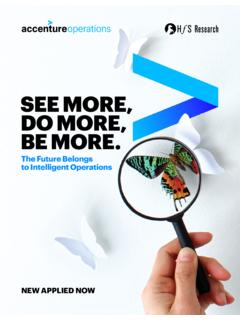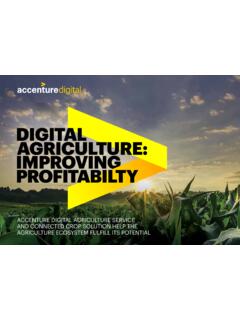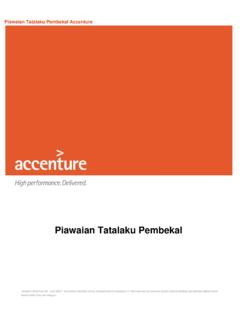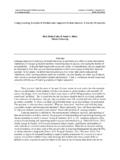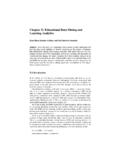Transcription of By Mark Purdy and Paul Daugherty - Accenture
1 By Mark Purdy and Paul Daugherty2 | Why artificial intelligence is the future of growthCONTENTSThe new factor of production 4 Three channels of AI-led growth 12 Factoring in AI 15 Clearing the path to an AI future 213 | Why artificial intelligence is the future of growthThere has been marked decline in the ability of increases in capital investment and in labor to propel economic progress. These two levers are the traditional drivers of production, yet they are no longer able to sustain the steady march of prosperity enjoyed in previous decades in most developed economies. But long-term pessimism is unwarranted. With the recent convergence of a transformative set of technologies, economies are entering a new era in which artificial intelligence (AI) has the potential to overcome the physical limitations of capital and labor and open up new sources of value and growth. Increases in capital and labor are no longer driving the levels of economic growth the world has become accustomed to and desires.
2 Fortunately, a new factor of production is on the horizon, and it promises to transform the basis of economic growth for countries across the , Accenture analyzed 12 developed economies and found that AI has the potential to double their annual economic growth rates by avoid missing out on this opportunity, policy makers and business leaders must prepare for, and work toward, a future with artificial intelligence. They must do so not with the idea that AI is simply another productivity enhancer. Rather, they must see AI as the tool that can transform our thinking about how growth is created. 4 | Why artificial intelligence is the future of growthThat missing element is how new technologies affect growth in the economy. Traditionally, capital and labor are the factors of production that drive growth in the economy (see Figure 5). Growth occurs when the stock of capital or labor increase, or when they are used more efficiently. The growth that comes from innovations and technological change in the economy is captured in total factor productivity (TFP).
3 Economists have always thought of new technologies as driving growth through their ability to enhance TFP. This made sense for the technologies that we have seen until now. The great technological breakthroughs over the last century electricity, railways and IT boosted productivity dramatically but did not create entirely new workforces. Given this poor outlook, commentators say that a stagnant economy is the new normal. On an even more pessimistic note, economist Robert Gordon argues that productivity growth over the next quarter century will continue at the sluggish pace we have experienced since He believes that the past two centuries of Great Inventions, such as the steamship and telegraph, are unlikely to be repeated. And this deficit of innovation, combined with unfavorable demographic trends, flagging educational attainment and rising wealth inequality, will slow economic progress. So, are we experiencing the end of growth and prosperity as we know it?
4 As grim as much of the data undoubtedly is, it misses an important part of the story. THE NEW FACTOR OF PRODUCTION Across the globe, rates of gross domestic product (GDP) growth have been shrinking. Moreover, this has been true for three decades. Key measures of economic efficiency are trending sharply downward, while labor-force growth across the developed world is largely stagnant. It is even in decline in some countries (see Figures 1 to 4). 5 | Why artificial intelligence is the future of growthSimilarly, AI can take the form of physical capital such as robots and intelligent machines. And unlike conventional capital, such as machines and buildings, it can actually improve over time, thanks to its self-learning capabilities. Based on our analysis and modeling, we can illustrate what happens when AI is seen as a new factor of production rather than just a productivity enhancer. The impact on projected growth for the United States, for example, is dramatic.
5 As Figure 6 shows, the first scenario is business-as-usual, assuming no AI effect. The second indicates the traditional view of AI as a TFP enhancer where it has a limited impact on growth. The third scenario shows what happens when AI can act as a new factor of production there is a transformative effect on growth. This ability of AI to complement and enhance traditional factors of production is where its true potential , we are witnessing the take-off of another transformative set of technologies, commonly referred to as artificial intelligence (see What is artificial intelligence? ). Many see AI as similar to past technological inventions. If we believe this, then we can expect some growth, but nothing transformational. But what if AI has the potential to be not just another driver of TFP, but an entirely new factor of production? How can this be? The key is to see AI as a capital-labor hybrid. AI can replicate labor activities at much greater scale and speed, and to even perform some tasks beyond the capabilities of humans.
6 Not to mention that in some areas it has the ability to learn faster than humans, if not yet as deeply. For example, by using virtual assistants, 1,000 legal documents can be reviewed in a matter of days instead of taking three people six months to The advance of AI is leading us to rethink fundamental economic relationships and how value is LEHRER, CEO, CONATIX6 | Why artificial intelligence is the future of growthDeveloped economies: The end of growth? On a variety of key measures, economic data seems to support a mood of long-term 1: GROSS DOMESTIC PRODUCTS ince the 1980s, GDP growth has steadily slowed in many large GDP growth (%, annual average over the period)NB: Data points across the dashed lines indicate the average for the six countries. Source: Oxford STATESUNITED | Why artificial intelligence is the future of growthFIGURE 2: PRODUCTIVITYA key measure of how well an economy uses its existing capital and people is total factor productivity (TFP).
7 Data show a weakening of TFP, especially in the past 10 factor productivity (%, annual average over the period)Source: The Conference Board, Total Economic 19941995 19992000 20042005 20092010 STATESUNITED KINGDOMFRANCEITALYGERMANY8 | Why artificial intelligence is the future of growthFIGURE 3: CAPITAL EFFICIENCYThe marginal capital efficiency rate, an indicator of the productivity of capital such as machines and buildings, has steadily dropped over a 50-year 4: LABORAs populations age and birth rates slow, fewer people are available to pick up the slack in the capital efficiency (%, 6-year moving average)Source: European Commission, Annual Macroeconomic DatabaseWorking age population (%, annual average growth over the period)Source: Oxford Economics1966197119761981198619911996200 1200620112016 UNITED STATESGERMANYJAPANUNITED | Why artificial intelligence is the future of growthFIGURE 5: THE AI GROWTH MODEL Our model adapts the traditional growth model by including AI as a factor of production.
8 FIGURE 6: THREE GROWTH SCENARIOS FOR THE UNITED STATES ECONOMYAI as a new factor of production can lead to significant growth opportunities for the United States economy. NB: indicates the change in that factor. Source: Accenture analysisUnited States gross value added (GVA) in 2035 (US$ billion)Source: Accenture and Frontier EconomicsGROWTHC apitalLaborTFPC apitalLaborTFPAIADAPTED GROWTH MODELTRADITIONAL GROWTH MODELUNITED STATES GVAAI INDUCED TFPADDITIONAL AI INDUCED GROWTH Projected growth without AI Projected growth with AI s impact limited to TFPP rojected growth with AI as new factor of production23,83523,83589789723,8357,4081 0 | Why artificial intelligence is the future of growthCONTENTSWHAT IS ARTIFICIAL INTELLIGENCE? AI is not a new field; much of its theoretical and technological underpinning was developed over the past 70 years by computer scientists such as Alan Turing, Marvin Minsky and John McCarthy. Today, the term refers to multiple technologies that can be combined in different ways to:SenseComputer vision and audio processing, for example, are able to actively perceive the world around them by acquiring and processing images, sounds and speech.
9 The use of facial recognition at border control kiosks is one practical example of how it can improve language processing and inference engines can enable AI systems to analyze and understand the information collected. This technology is used to power the language translation feature of search engine results. ActAn AI system can take action through technologies such as expert systems and inference engines, or undertake actions in the physical world. Auto-pilot features and assisted-braking capabilities in cars are examples of three capabilities are underpinned by the ability to learn from experience and adapt over time. AI already exists to some degree in many industries but the extent to which it is becoming part of our daily lives is set to grow | Why artificial intelligence is the future of growth11 | Why artificial intelligence is the future of growthCONTENTSTwo key factors are enabling AI growth: Emerging AI technologies1. Unlimited access to computing power.
10 Public cloud computing was estimated to reach almost US$70 billion in 2015 worldwide. Data storage has also become abundant. 2. Growth in big data. Global data has seen a compound annual growth rate (CAGR) of more than 50 percent since 2010 as more of the devices around us have become connected. As Barry Smyth, professor of computer science at University College Dublin, told us: Data is to AI what food is to humans. So in a more digital world, the exponential growth of data is constantly feeding AI : Accenture analysis11 | Why artificial intelligence is the future of growthNatural Language ProcessingKnowledge RepresentationILLUSTRATIVE SOLUTIONSC omprehendComputer VisionAudio ProcessingAI TECHNOLOGIESS enseMachine LearningExpert SystemsActVirtualAgentsDataVisualization RecommendationSystemsCognitiveRoboticsSp eech AnalyticsIdentityAnalytics12 | Why artificial intelligence is the future of growthTHREE CHANNELS OF AI-LED GROWTH With AI as the new factor of production, it can drive growth in at least three important ways.
